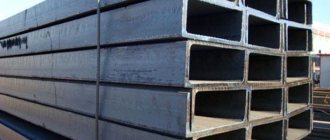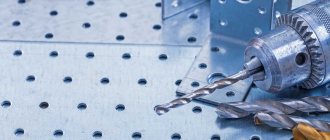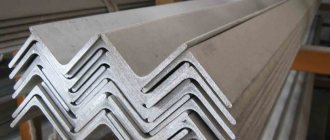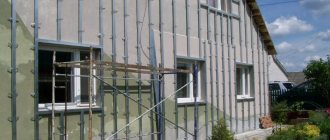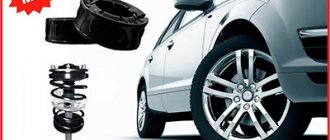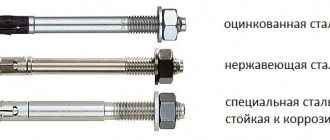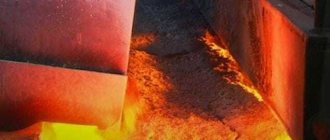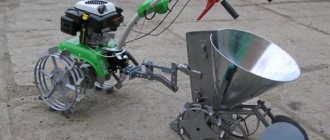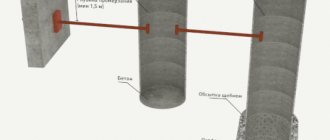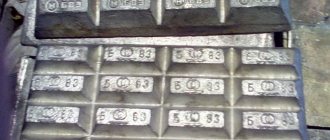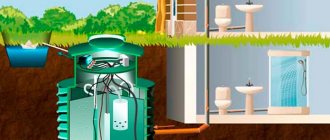An I-beam is a long shaped product with a complex H-shaped configuration, which makes it possible to achieve high structural strength and resistance to loads of any kind.
Taking this into account, builders use I-beams when they want to achieve high reliability of supporting and load-bearing structures during the construction of various objects, from civil to industrial.
Such supports are created, as a rule, from two types of I-beams - welded and hot-rolled. Both eliminate the occurrence of shrinkage, shifts, cracking, and other possible situations.
Metal beams
Any metal I-beams are manufactured in strict accordance with the requirements of GOST and TU, so they have a regulated shape and composition. Thanks to this, having the necessary documentation, you can easily calculate the required dimensions and parameters of I-beams required for a specific design.
Geometric characteristics are:
- Height is the distance between two flat areas, called flanges, in the section of an I-section.
- Width is the length of the I-beam shelves.
- Wall thickness is the thickness of the middle plane located between the shelves. This parameter is one of the most important, since the load-bearing capacity and strength of the I-beam directly depends on the wall thickness.
- Average shelf thickness. The I-beam shelves are not rectangular, but have an irregular shape. Towards the ends of the shelf they narrow, and in the middle of the shelf, where it abuts the wall, they expand inward. Therefore, the average thickness of the shelf is calculated using the following formula: shelf width minus wall thickness divided by four.
- The radius of internal rounding is the parameter for rounding the shelf at its junction with the wall. Due to the fact that the shelf does not adjoin the wall at a right angle, but along a radius, its strength characteristics increase. The radius of curvature of the shelf. Since such thickness is not required at the ends of the flange and the main load goes to the center of the beam on the wall, the flanges of the I-beam taper along the radius.
- Slope of the inside of the shelf. The shelf can also run at a certain angle along the inside, widening towards the center.
The technical characteristics of the I-beam directly depend on these parameters, so all of them are specified in GOST and must be performed in strict accordance with them.
I-beam size 16, modifications and scope of application
The production of I-beams of this size is regulated by state standards. The scope of its application is quite wide: industrial and residential facilities, pavilions, columns, storage facilities, bridges, etc.
I-beam profiles No. 16 come in several types. It is technically possible to produce beams where the edges of the shelves are parallel, profiles with an inclination of the inner edge from 6% to 12% and with an inclination from 12% to 16%. Welded profiles are also produced, where the upper and lower flanges are attached to the base. As a variation of this profile, there is a non-standard I-beam, where the width of the upper and lower shelves is different.
I-beam 16, the dimensions of which are capable of providing high rigidity, is used for the construction of structures with long-term static and design loads.
I-beams with a slope of up to 12% are a reinforced modification of the profile and are suitable for general use. Profiles with a slope of 12% are marked “M”. They are intended for use when installing overhead tracks. Profiles marked with the letter “C” are characterized by an inclination of the internal shelves of 16%. They are used to strengthen or reinforce mine shafts.
I-beam 16 has a total height of 160 mm. The total width of the beam is 81 mm. The thickness of the profile wall is 5 mm. The average shelf thickness is 7.8 mm. One meter of I-beam weighs 15.89 kg according to GOST.
What to consider when calculating an I-beam
To minimize waste and simplify the design, it is necessary to correctly perform the calculation. Such calculations can be performed independently, or they can be ordered from a design office.
The calculation is performed based on the following data:
- the length of the span in which the beam is planned to be used;
- load size - standard and design;
- calculated resistance, by default it is taken equal to 210 MPa;
- it is necessary to calculate the moment of axial resistance.
Having received the calculation results, you can select the required type of profile using the I-beam assortment table.
But, the designer must also take into account the fact that I-beams work very poorly in torsion, in comparison with a round beam.
Production of welded I-beam
Welded products are made from sheet metal. The quality of the finished beam depends on the welding equipment used for its production. During production, the following operations are carried out:
- Cutting steel sheets on CNC machines (less commonly, thermal cutting equipment is used for this).
- Welding of workpieces on automated lines using hydraulic clamps.
- Editing the product to achieve the prescribed geometry.
IMPORTANT: I-beams made using outdated equipment from low-carbon steel grades lead to the fact that such building elements have low performance characteristics. Welded beams produced on modern equipment are not inferior in their properties to hot-rolled analogues. With the correct technology for their manufacture, they will help to achieve the necessary conditions for the construction of all types of buildings and structures.
The use of welding in the production of such metal products makes it possible to produce beams with different widths and thicknesses of shelves. The customer can receive a welded I-beam of a certain length, with holes and cutouts ready for fastening the structure.
I-beam channels have universal characteristics:
- Optimal shape for material consumption.
- High strength indicators.
- The parameters are specified in standards and specifications.
The disadvantages of hot-rolled metal structures of this kind are:
- Low resistance to torsion (this indicator is 400 times lower compared to a round beam).
- The difficulty of producing large sizes and their shortage on the market.
- High metal consumption of production.
Most sizes of hot rolled I-beams are available on the same day of purchase. Welded elements are most often produced to order. Therefore, you have to wait until the manufacturer finishes working on your beams.
Application
I-beam is widely used in the construction of civil, industrial and public buildings. For the construction of large-panel buildings, as well as high- and low-rise private houses. The profile acts as a load-bearing element in many structures:
- overpasses and bridges;
- mines and subways;
- tunnels for railway and conventional transport;
- designs of pits and devices for strengthening the coastline;
- production workshops, warehouses;
- cargo platforms, railway cars and transport ships.
In addition, the building element is quite popular when constructing attic spaces. It is successfully used in rafter systems and during roof installation.
Beams are used not only in the construction of reinforced concrete structures or metal structures, but also in the construction of wooden houses and stairs.
I-beams are used for spans that are wide enough to support concrete structures. In this case, the ceiling, unlike the beam, will not be able to withstand the expected load.
Regardless of the material, I-beams are reliable construction materials. In addition, the profiles, with the exception of some types, are lightweight, which makes them easy to transport to the construction site. Working with I-beams is not particularly difficult: installation is carried out using welding, as well as rivets and bolts.
In what structural elements is it used?
Such metal products are opening up new areas of use every day. Demand for them will encourage manufacturers to improve the process of creating beams. Today they are used not only in multi-storey buildings, but also in private construction.
I-beam structures tolerate bending resistance well. It is advisable to include them in the design of load-bearing elements:
- Column.
- Overlapping elements.
- Suspended tracks.
- Structures of frames of cars, cars and special equipment.
- Frames of mines and tunnels.
In the designs of moderately loaded trusses, a wide-flange I-beam is used. In order to reduce the cost of construction without reducing the strength of the structure, accurate calculation and selection of beams is necessary. This procedure must be entrusted to specialized architectural or design firms. Specialists of these bureaus will carry out calculations according to:
- Standard load (the corresponding GOST is used).
- The number of elements used in one beam.
- Average resistance value (according to steel grade).
When using floors made from beams of this profile, reinforced concrete, metal or brick columns and walls serve as support. Installation of formwork and construction of supports is carried out using measuring equipment. I-beams are mounted on supports so that they extend onto the support by at least 20 cm.
If it is necessary to join elements, the requirement of SP 16.13330.2011 is used. It prescribes three methods for this procedure:
- Butt welding of pre-milled ends.
- Bolted or welded linings.
- Flanges and bolts.
The I-beam is connected to the column with bolts. Installation is carried out using temporary connections, which are then replaced by the main ones. After installing such a beam, it must be protected from corrosion. For this purpose, special paint and varnish compositions are used. Until the main fastening is installed, the beam cannot be used. Designs using such elements are highly reliable and durable.
| Normal I-beams (without slope of the internal edges of the shelves) | |||||||
| Profile designation | Profile dimensions | Sectional area, F, sq.cm | Weight 1m, kg/m | ||||
| h | b | s | t | R | |||
| mm | |||||||
| 20B1 | 200 | 100 | 5,5 | 8 | 11 | 27,16 | 21,3 |
| 25B1 | 248 | 124 | 5 | 8 | 12 | 32,68 | 25,7 |
| 25B2 | 250 | 125 | 6 | 9 | 12 | 37,66 | 29,6 |
| 30B1 | 298 | 149 | 5,5 | 8 | 13 | 40,8 | 32 |
| 30B2 | 300 | 150 | 6,5 | 9 | 13 | 46,78 | 36,7 |
| 35B1 | 346 | 174 | 6 | 9 | 14 | 52,68 | 41,4 |
| 35B2 | 350 | 175 | 7 | 11 | 14 | 63,14 | 49,6 |
| 40B1 | 396 | 199 | 7 | 11 | 16 | 72,16 | 56,6 |
| 40B2 | 400 | 200 | 8 | 13 | 16 | 84,12 | 66 |
| 45B1 | 446 | 199 | 8 | 12 | 18 | 84,3 | 66,2 |
| 45B2 | 450 | 200 | 9 | 14 | 18 | 96,76 | 76 |
| 50B1 | 492 | 199 | 8,8 | 12 | 20 | 92,38 | 72,5 |
| 50B2 | 496 | 199 | 9 | 14 | 20 | 101,27 | 79,5 |
| 50B3 | 500 | 200 | 10 | 16 | 20 | 114,23 | 89,7 |
| 55B1 | 543 | 220 | 9,5 | 13,5 | 24 | 113,36 | 89 |
| 55B2 | 547 | 220 | 10 | 15,5 | 24 | 124,75 | 97,9 |
| 60B1 | 596 | 199 | 10 | 15 | 22 | 120,45 | 94,6 |
| 60B2 | 600 | 200 | 11 | 17 | 22 | 134,41 | 105,5 |
| wide-flange I-beams | |||||||
| 20Ш1 | 194 | 150 | 6 | 9 | 13 | 39,01 | 30,6 |
| 25Ш1 | 244 | 175 | 7 | 11 | 16 | 56,24 | 44,1 |
| 30Ш1 | 294 | 200 | 8 | 12 | 18 | 72,38 | 56,8 |
| 30Ш2 | 300 | 201 | 9 | 15 | 18 | 87,38 | 68,6 |
| 35Ш1 | 334 | 249 | 8 | 11 | 20 | 83,17 | 65,3 |
| 35Ш2 | 340 | 250 | 9 | 14 | 20 | 101,51 | 79,7 |
| 40Ш1 | 383 | 299 | 9,5 | 12,5 | 22 | 112,91 | 88,6 |
| 40Ш2 | 390 | 300 | 10 | 16 | 22 | 135,95 | 106,7 |
| 45Ш1 | 440 | 300 | 11 | 18 | 24 | 157,38 | 123,5 |
| 50Ш1 | 482 | 300 | 11 | 15 | 26 | 145,52 | 114,2 |
| 50Ш2 | 487 | 300 | 14,5 | 17,5 | 26 | 176,34 | 138,4 |
| 50Ш3 | 493 | 300 | 15,5 | 20,5 | 26 | 198,86 | 156,1 |
| 50Ш4 | 499 | 300 | 16,5 | 23,5 | 26 | 221,38 | 173,8 |
| column I-beams | |||||||
| Profile designation | Profile dimensions | Sectional area, F, sq.cm | Weight 1m, kg/m | ||||
| h | b | s | t | R | |||
| mm | |||||||
| 20K1 | 196 | 199 | 6,5 | 10 | 13 | 52,69 | 41,4 |
| 20K2 | 200 | 200 | 8 | 12 | 12 | 63,53 | 49,9 |
| 25K1 | 246 | 249 | 8 | 12 | 16 | 79,72 | 62,6 |
| 25K2 | 250 | 250 | 9 | 14 | 16 | 92,18 | 72,4 |
| 25K3 | 253 | 251 | 10 | 15,5 | 16 | 102,21 | 80,2 |
| 30K1 | 298 | 299 | 9 | 14 | 18 | 110,8 | 87 |
| 30K2 | 300 | 300 | 10 | 15 | 18 | 119,78 | 94 |
| 30K3 | 300 | 305 | 15 | 15 | 18 | 134,78 | 105,8 |
| 30K4 | 304 | 301 | 11 | 17 | 18 | 134,82 | 105,8 |
| 35K1 | 342 | 348 | 10 | 15 | 20 | 139,03 | 109,1 |
| 35K2 | 350 | 350 | 12 | 19 | 20 | 173,87 | 136,5 |
| 40K1 | 394 | 398 | 11 | 18 | 22 | 186,81 | 146,6 |
| 40K2 | 400 | 400 | 13 | 21 | 22 | 218,69 | 171,7 |
| 40K3 | 406 | 403 | 16 | 24 | 22 | 254,87 | 200,1 |
| 40K4 | 414 | 405 | 18 | 28 | 22 | 295,39 | 231,9 |
| 40K5 | 429 | 400 | 23 | 35,5 | 22 | 370,49 | 290,8 |
| I-BEES WITH SLOPE OF THE INNER EDGES OF THE SHELVES | |||||||
| Profile designation | Profile dimensions | Sectional area, F, sq.cm | Weight 1m, kg/m | ||||
| h | b | s | t | R | |||
| mm | |||||||
| GOST 19425-74 | |||||||
| 24M | 240 | 110 | 8,2 | 14 | 10,5 | 48,7 | 38,3 |
| 30M | 300 | 130 | 9 | 15 | 12 | 64 | 50,2 |
| 36M | 360 | 130 | 9,5 | 16 | 14 | 73,8 | 57,9 |
| 45M | 450 | 150 | 10,5 | 18 | 16 | 98,8 | 77,6 |
| GOST 8239-89 | |||||||
| 60 | 600 | 190 | 12 | 17,8 | 20 | 138 | 108 |
Assortment
For construction needs, I-beam is a universal material that may be needed for different purposes. As a rule, the products are used in a number of industries - metro construction, bridge construction, etc.
The production of I-beams is regulated by GOST 8239, GOST 19425, etc. They indicate the main dimensions, maximum deviations, as well as rules for marking products.
Hot-rolled I-beam with flange slope
This type stands out among others due to the small internal slope of the shelves relative to the wall - we are talking about the range of 6-12%.
Depending on the quality of rolling, the following are produced:
● beams with increased accuracy – there is a letter “B” in the marking;
● beams with normal accuracy – designated by the letter “B”.
Such beams are used, for example, for suspended tracks in various structures that work in bending.
There are beams made of the same material, but with a greater slope of 12-16% (GOST 19425). According to GOST, it can withstand compressive loads well and is used to strengthen powerful structures, for example, mine shafts and subways. They are designated by the letter “M”.
The following three types of hot-rolled products have one common feature - the absence of slope of the shelves and their parallel edges.
I-beams are normal
This type of pipe offers characteristic classic dimensional ratios, when the width of the I-beam flange is half the height of the profile.
Normal I-beams are designated by the letter "B". They have proven themselves well in construction as supports or elements of lattice columns. They are also in demand in mechanical engineering, where they are used to create frames for trucks and wagons, and in the industrial sector, where they are used to create crane tracks for electric bridge cranes and other metal structures.
| I-beam number | h | b | s | t | Weight 1m, kg | Meters per ton |
| Normal | ||||||
| 20B1 | 200 | 100 | 5.5 | 8 | 21.3 | 46.9 |
| 25B1 | 248 | 124 | 5 | 8 | 25.7 | 38.9 |
| 25B2 | 250 | 125 | 6 | 9 | 29.6 | 33.8 |
| 30B1 | 298 | 149 | 5.5 | 8 | 32 | 31.3 |
| 30B2 | 300 | 150 | 6.5 | 9 | 36.7 | 27.2 |
| 35B1 | 346 | 174 | 6 | 9 | 41.4 | 24.2 |
| 35B2 | 350 | 175 | 7 | 11 | 49.6 | 20.2 |
| 40B1 | 396 | 199 | 7 | 11 | 56.6 | 17.7 |
| 40B2 | 400 | 200 | 8 | 13 | 66 | 15.2 |
| 45B1 | 446 | 199 | 8 | 12 | 66.2 | 15.1 |
| 45B2 | 450 | 200 | 9 | 14 | 76 | 13.2 |
| 50B1 | 492 | 199 | 8.8 | 12 | 72.5 | 13.8 |
| 50B2 | 469 | 199 | 9 | 14 | 79.5 | 12.6 |
| 55B1 | 543 | 220 | 9.5 | 13.5 | 89 | 11.2 |
| 55B2 | 547 | 220 | 10 | 15.5 | 97.9 | 10.2 |
| 60B1 | 596 | 199 | 10 | 15 | 94.6 | 10.6 |
| 60B2 | 600 | 200 | 110 | 17 | 105.5 | 9.5 |
Wide-flange I-beams
The width of the shelves has been almost doubled, which is reflected in the marking using the letter “W”. Its strength and rigidity indicators are also significantly higher than the standard one.
Thanks to these properties, wide-flange I-beams are used for the manufacture of the following structures:
● support, rafter beams;
● frames for cars, trailers;
● foundation piping, etc.
| I-beam number | h | b | s | t | Weight 1m, kg | Meters per ton |
| Wide shelf | ||||||
| 20Ш1 | 194 | 150 | 6 | 9 | 30.6 | 32.7 |
| 25Ш1 | 244 | 175 | 7 | 11 | 44.1 | 22.7 |
| 30Ш1 | 294 | 200 | 8 | 12 | 56.8 | 17.6 |
| 30Ш2 | 300 | 201 | 9 | 15 | 68.6 | 14.6 |
| 35Ш1 | 334 | 249 | 11 | 20 | 65.3 | 15.3 |
| 35Ш2 | 340 | 250 | 9 | 14 | 79.7 | 12.5 |
| 40Ш1 | 383 | 299 | 9.5 | 12.5 | 88.6 | 11.3 |
| 40Ш2 | 390 | 300 | 10 | 16 | 106.7 | 9.4 |
| 45Ш1 | 440 | 300 | 11 | 18 | 123.5 | 8.1 |
| 50Ш1 | 482 | 300 | 11 | 15 | 114.2 | 8.8 |
| 50Ш2 | 487 | 300 | 14.5 | 17.5 | 138.4 | 7.2 |
| 50Ш3 | 493 | 300 | 15.5 | 20.5 | 156.1 | 6.4 |
| 50Ш4 | 499 | 300 | 16.5 | 23.5 | 173.4 | 5.8 |
Column I-beams
This type is distinguished by thicker walls and shelves, so such I-beams can withstand significant loads.
Increased strength parameters allow the use of this material in the following cases:
● construction of various vertical supports;
● construction of various buildings for the civil and industrial sectors;
● formation of the frame of load-bearing structures during the construction of various fortification engineering structures - bridges, dams.
Resistance to various loads and impacts allows the use of this material in difficult climatic zones. It is also well suited for seismically active areas. The letter “K” is used to mark such beams.
| I-beam number | h | b | s | t | Weight 1m, kg | Meters per ton |
| Columned | ||||||
| 20K1 | 196 | 199 | 6.5 | 10 | 41.4 | 24.2 |
| 20K2 | 200 | 200 | 8 | 12 | 49.9 | 20 |
| 25K1 | 246 | 249 | 8 | 12 | 62.6 | 16 |
| 25K2 | 250 | 250 | 9 | 14 | 72.4 | 13.8 |
| 25K3 | 253 | 251 | 10 | 15.5 | 80.2 | 12.5 |
| 30K1 | 298 | 299 | 9 | 14 | 87 | 11.5 |
| 30K2 | 300 | 300 | 10 | 15 | 94 | 10.6 |
| 30K3 | 300 | 305 | 15 | 15 | 105.8 | 9.5 |
| 30K4 | 304 | 301 | 11 | 17 | 105.8 | 9.5 |
| 35K1 | 342 | 348 | 10 | 15 | 109.1 | 9.2 |
| 35K2 | 350 | 350 | 12 | 19 | 136.5 | 7.3 |
| 40K1 | 394 | 398 | 11 | 18 | 146.6 | 6.8 |
| 40K2 | 400 | 400 | 13 | 21 | 171.7 | 5.8 |
| 40K3 | 406 | 403 | 16 | 24 | 200.1 | 5 |
| 40K4 | 414 | 405 | 18 | 28 | 231.9 | 4.3 |
| 40K5 | 429 | 400 | 23 | 35.5 | 290.8 | 3.4 |
Peculiarities
The main feature of the I-beam is its shape. Thanks to it, it has unique physical and technical characteristics. This form is very convenient to use - because it has two parallel flat edges (shelves).
Therefore, its application is very wide. It is used both in the construction of vertical (supports, walls) and horizontal structures (floors). Another feature of the I-beam, depending on the shape, is its physical characteristics. It has high strength to dynamic and static loads.
For example, a metal I-beam is seven times stronger and 30 times stiffer than a rectangular or square profile of the same weight. And its rigidity directly depends on the length and thickness of the wall.
Purpose
Metal I-beams are the basis of many modern structures. They have been widely used in past centuries, earning a reliable reputation. Therefore, their use can be found almost everywhere.
They are used in the construction of residential, industrial and commercial premises, hangars, various technical structures, mechanical engineering, automotive industry, carriage building and so on.
Due to their high strength, resistance to dynamic loads and load-bearing capacity, they are also used:
- during the construction of supports for structures with high loads (towers, high-rise buildings, platforms, etc.);
- in the construction of railway and road bridges;
- in the mining industry, during the construction of mines.
Types of hot-rolled I-beams depending on the steel grades used
The material for the manufacture of I-roll products is selected in accordance with the planned climatic conditions, the nature and magnitude of the loads. Possible options:
- In the mass production of I-roll products, designed for operation in standard climatic conditions and under moderate loads, carbon steels of ordinary quality are used. Their characteristics are regulated by GOST 380-2005. According to the degree of deoxidation, they are divided into calm (the highest quality), semi-calm and boiling. In modern production, approximately 80% of metal products are made from steels that comply with GOST 380-2005 due to the combination of moderate cost and good performance characteristics.
- Construction steels complying with GOST 27772-2015. Such grades for shaped and long products are of higher quality compared to steels produced in accordance with GOST 380-2005, due to strict requirements for the chemical composition.
- Low-alloy steels from which high-strength rolled products are made, corresponding to GOST 19281-2014. These alloys are alloyed with small amounts of aluminum, silicon, and manganese. Products made from low-alloy steels are more resistant to dynamic loads and low operating temperatures.
- Structural alloy steels for bridge construction are used for rolled metal products that comply with GOST 55374-2023-12.
Advantages and disadvantages
First of all, it should be said that according to the production method, a distinction is made between welded and hot-rolled I-beams. Hot rolled ones are made by rolling steel and shaping a metal blank into an I-beam shape.
Welded ones are obtained by welding three separate flat elements that form the wall and shelves. Each of them has its own advantages and disadvantages.
The advantages of hot rolled steel are:
- solidity;
- no seams;
- simplicity and low cost of production.
As a result, it has higher strength and reliability.
The disadvantages of hot rolled steel include:
- Large wall thickness. Due to the thickening of the walls, the mass of the I-beam itself increases, and consequently the entire structure as a whole. Which can lead to increased construction costs (for example, when pouring a foundation, reinforced belt).
- Limited sizes. Russian factories produce beams with a flange width of no more than 400 millimeters. In addition, they are produced in a certain length - 12 meters. And if, for example, you need a smaller beam, you will have to cut off the excess and throw it away. In this case, its cost increases.
- Possibility of production only at large enterprises. If the construction site is located in the city where such a plant is located, then this is a plus. But if not, then the cost of a monolithic beam also includes transportation costs.
The undoubted advantages of welded ones are:
- Possibility to choose the right sizes. Thanks to this, you can order a beam of the desired length, shelf width and wall height. As a result, the client pays only for what he needs and of almost any size.
- Additional design features. Depending on the customer’s requirements, the welded beam can be manufactured with different flanges, flange connections, additionally reinforced with stiffeners, perforated and have a bimetallic composition.
- Relatively light weight. A welded beam is a lighter structure, which allows you to save additional money during foundation work and construction of walls.
The disadvantages of welded are:
- Presence of seams. This significantly reduces the strength of the structure. Especially if the welding is defective. But if necessary, it can be reinforced with stiffeners.
- Use of additional parts for reinforcement. The use of reinforcement or other material when creating stiffeners leads to additional costs of money and time, which leads to increased costs.
Welded I-beam
A welded I-beam product is produced by welding three basic components. Welding is carried out on both sides so that the product is as reliable and durable as possible. It is important to ensure that the elements fit as tightly as possible and are strictly perpendicular to each other. When welding, there is a need to use additional elements to recreate the stiffeners, and serious labor resources must be involved in this process; all this must be taken into account at the design stage during construction. It is worth noting that the introduction of additional ribs, for reinforcement, reduces the thickness of the wall and lowers its overall metal consumption; since the required amount of metal is reduced, the cost is reduced, and all mechanical properties remain unchanged.
For manufacturing by welding, materials such as profile and metal sheets are used; for belts, bent profiles, channels and much more can be used.
Advantages of a welded I-beam
- An undoubted advantage is that the lighter weight of the beam product allows you to reduce the total weight of the metal product, and therefore reduce the overall cost of the construction project.
- An important advantage of welded beam products is that it is produced according to a given technical specification, and on an individual order. Let's consider an example, for the construction of a certain structure it is necessary to erect metal structures, where the length of the beam should be 10.55 meters, then a profile with exactly this length will be welded. Thus, the customer will avoid additional waste, and therefore costs.
- According to the technical specifications for individual projects, this type of profile can be made perforated, which reduces the weight of the structure, can have a truncated shape, have unequal flanges, with flange connections or additional stiffeners; complex architectural structures can be created from such rolled metal. A beam product of such shapes cannot be obtained at a metallurgical plant.
- It is possible to weld metal products with a variable cross-section; this will allow the metal to be distributed in such a way that in loaded areas of the structure, the rigidity will be higher, reducing the cost of the structure without losing quality characteristics.
The procedure for manufacturing a welded I-beam
The following main phases of welding are distinguished:
- cutting and cutting sheets into strips;
- processing of edges on a machine, which is necessary to improve weldability;
- positioning and fixing strips on the machine to avoid shifts;
- the welding process itself;
- trimming and straightening on a machine;
- cleaning from rust, dirt and oil.
Disadvantages of a welded I-beam
Despite all the above advantages, welded production will never be able to displace rolled production from the market, since the speed and production volumes of welded beams are several times inferior to rolling production. And the speed of construction work throughout the country is very high, thus, the demand in the market for this type of metal products can only be covered by the combined volumes of both welding and rolling production.
Corrugated beams: great savings
Although the corrugated beam looks interesting, in Russia such a design began to be used back in the 30s of the last century. Then something similar was used in wooden structures. Today, such beams are welded in several metallurgical plants in the country.
Now this type of beam is a welded lightweight structure made of corrugated sheets, which is welded to steel shelves. Moreover, the shelves themselves are made of hot rolled steel, and the profiled sheet is cold rolled.
Look what these beams look like:
The idea of corrugating the walls of such beams was arrived at in order to save money, or, to put it in literate language, to reduce the metal consumption of construction. Naturally, the corrugated wall can be thinner than a regular metal one (only 1.5-1.8 mm), because it already has transverse ribs.
Which, in addition, also increases the torsional rigidity of the beam itself! And, therefore, it allows you to get rid of the main drawback that is characteristic of the I-beam. Here the stress develops only at the belts, drops almost to zero, and all tangential stresses are evenly distributed along the height of the walls.
The corrugation itself can be either wavy or triangular (this is considered more technologically advanced). An even stronger beam does not have vertical corrugations, but horizontal ones.
In total, the corrugations are located to the upper belt at an angle of 45-50°, with the calculation of the ratio of the wave height to its length from 1/5 to 1/20.
Compared to conventional hot-rolled I-beams, corrugated beams are 20-40% more economical. Not only do such beams weigh less, but the profiling itself gives greater rigidity during rotation, and therefore fewer special lifting devices are used in the installation of such beams in the form of additional angles and ties. This greatly simplifies installation.
Corrugated beams are good as roofing purlins with a span of 9 m and as a load-bearing base in high-rise buildings with spans up to 24 meters.
The only significant drawback of such structures is that they are quite labor-intensive to manufacture. But, due to the fact that such beams do not have stiffeners, metal consumption and the length of welds are reduced.
How to find out the exact weight of a construction I-beam?
An important part of metal fabrication that needs to be mentioned from a technical perspective is calculating the weight of the I-section used for each project. The calculation is based on the profile number, which can be found in the assortment of I-beams, where you can also see the mass and cross-sectional area. It is worth paying attention that the table shows the mass of one linear meter.
In order to find out the weight of an I-beam, you can weigh the material.
It is important to understand that this procedure is carried out only during the shipment of the construction I-beam in order to find out exactly how much the supplier is releasing to the customer.
However, there are some cases when weighing beams is not possible in principle. In this situation, mathematical calculations will help. To do this, take individual I-beams and calculate them by multiplying the length by the weight of one linear meter. It is important to understand that the entire footage of the product in such specific cases can be found out by measuring the length. The specific gravity of an I-beam metal structure is calculated using one of the following methods:
- Look at the values of the characteristics specified in the table of the state standard.
- Calculated manually.
It is worth knowing that the values of the linear meter of the beam were determined manually using calculation methods. Calculations were used for beams with a nominal size, and the metal density was taken to be absolutely identical to the average value. Real materials are often produced in slightly different sizes than the base ones. It is precisely this difference that is allowed according to GOST, and is called the maximum possible deviations during production.
Profile features, dimensions and weight of I-beam 30
The production of I-profile No. 30 is regulated by the regulatory documentation mentioned above. These I-beams are produced in two modifications: a regular I-beam and an I-beam with increased accuracy (marked “A”).
It should be noted that the dimensions of I-beam 30, as well as profiles of other sizes, differ depending on the accuracy. The weight of the product also changes accordingly, which is of fundamental importance for some buildings.
Steel beam No. 30 is maximally resistant to deformation and can withstand enormous loads.
A meter beam 30B1 weighs 32.9 kg. The dimensions of the 30b1 I-beam are as follows: the height of the metal beam is 296 mm, its width is 140 mm. The wall thickness is 4.8 mm, the shelf is 5.8 mm. The length of profile 30b1 ranges from 4 m to 12 m.
The dimensions of the I-beam 30w1 are different. The profile has a height of 291 mm, the width of the shelf is 200 mm, the thickness of the lintel is 8 mm and the thickness of one shelf is 11 mm. The beam length varies from 4 m to 13 m. A 1 meter long profile weighs 36.48 kg.
The high-precision I-beam profile has a height of 300 mm, a width of 145 mm, and a lintel thickness of 6.5 mm. The thickness of one shelf is 10.7 mm. At the same time, the mass of a meter high-strength I-beam is 39.17 kg.
The 30 cm beam is used in the construction of powerful lifting mechanisms, support structures and in the construction of mine shafts.
Types of I-beams
The I-beam can be found in two variations - hot-rolled and welded. Each of these two types offers its own advantages and disadvantages.
Let's look at each group in more detail.
Hot rolled I-beams
When you need to make an I-beam, the easiest way to do this is to use hot rolling mills. By using blanks, subjecting the material to the compressive action of numerous rolls, the blank eventually elongates and then acquires the recognizable H-shaped profile.
Now let's look at the advantages and disadvantages of using the material.
| Advantages | Flaws |
| solidity, since the beams do not have connecting welds | various marks quickly remain on the surface of the beam |
| their production is relatively simple | limited assortment leading to pre-agreed custom size and single production, which increases waiting time |
| higher levels of rigidity and strength than conventional metal structures | There is no way to reduce the cost of the material due to the combination of different types of steel. |
Welded I-beams
The technology for producing welded I-beams is somewhat different: strips are cut from a sheet blank of the required thickness. Then they are welded into an H-shaped structure of the required configuration.
Welding seams must be carefully checked for strength and quality. To do this, they undergo ultrasonic testing, are polished, and the product is coated with a protective layer.
Welded I-beams are preferred when it is necessary:
● obtain a clean surface of the product;
● produce beams with different widths/thicknesses, not specified in GOST standards;
● use different types of steel for specific purposes (to give special properties, reduce the weight of the structure, and also to reduce cost).
